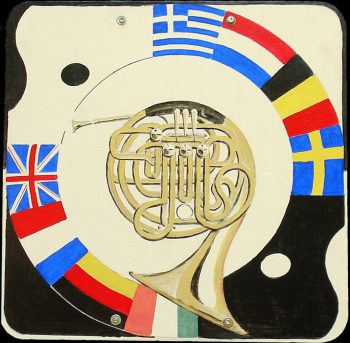Τσακώνικος χορός |
Tsakónikos dance
Environmental portrait of my daughter Greetje
oil on canvas (cotton)
3 × 100 × 100 cm
December 2013
Left panel
Middle panel
Right panel
The Tsakónikos is a dance from the Peloponnese in Greece, more specifically from the region known as Tsakonia, for the most part situated in Arcadia.
This triptych is an expression of my love for my family and for the cradle of western civilization, for me personally to be celebrated by way of ‘listening, watching and tasting together’. However, the scene also refers to a different, and unfortunately common, view of Greece nowadays, a view exclusively determined by money. What does money represent anyway . . . ?
Reminiscence:
- Δύο πόρτες έχει η ζωή ‘Life has two doors’ (Στέλιος Καζαντζίδης)
» Read more
I was introduced to this dance somewhere at a village festival in 1976. The combination of this dance with the typical costumes was something I saw later in the theatre of Dora Stratou on Philopappos Hill in Athens. Wikipedia mentions the following:
The dance is performed to a 5/4 (3+2) rhythm in an open circle which slowly winds in upon itself, forming a snail-shaped design. This labyrinthine formation is, according to legend, linked to the Crane dance of Theseus in Greek mythology, who slew the Minotaur in the Labyrinth of King Minos. It also has been linked to the slaying by Apollo of the Python at Delphi.
Music and dance, just like love, have the property to enrich all involved. For me, dance is a wonderful metaphor to show this exchange. A monetary exchange, however, does not always fulfill an enriching role for all involved; on the contrary, it often does only for one party at the expense of the other. Money all too easily also represents negative values such as power, violence, fraud and corruption.
To conclude, a citation:
Apollo, the god of light, defeated Hermes in running and Ares in boxing – mind conquered time, light conquered the dark forces of fraud and violence
(Report to Greco, pilgrimage through Greece, by Nikos Kazantzakis)
» Read less

